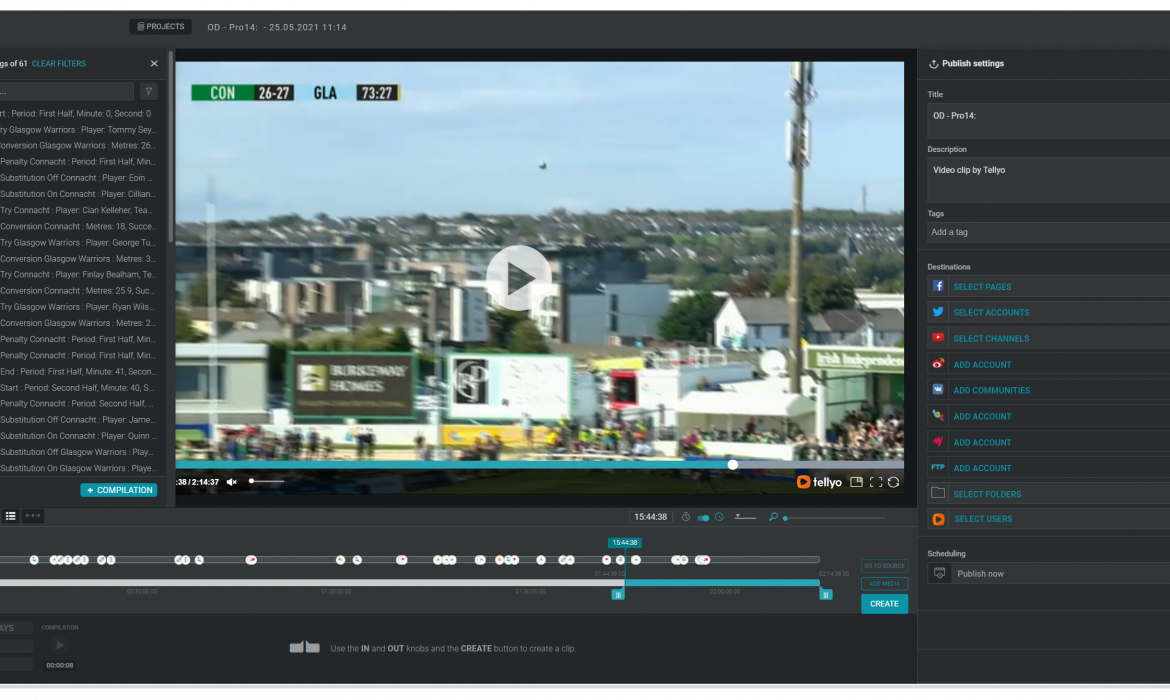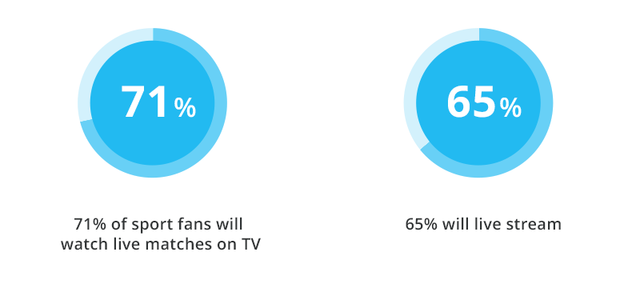Great sports making great video content
The best sports are full of drama, thrills and emotion that connect us with events when watched live or through the lens of social media. In fact, social media often gets us closer to the moments that really matter, helping us to see and feel the drama as it unfolds.
Check out the following thrilling and emotive videos from these socially-innovative sports organizations.
Guinness PRO14 Rugby
The Guinness PRO14 rugby tournament is a global brand with a TV rights deal and an innovative digital team making the most of social videos, too. Our Tellyo Pro platform is being utilised to create compelling highlights from live games and clip moments to provide videos of crucial events for social audiences, all in a matter of seconds.
Union Cycliste Internationale (UCI)
The UCI is responsible for numerous cycling events around the world, with one of the most prestigious being the UCI World Road Championships.
2018’s UCI World Road Championship was held in Innsbruck, Austria. The event, involved the best riders in the world, while some routes had approximately 5,000 metres of altitude, making it truly challenging. The Championships were broadcasted to 150 countries, with short video clips also shared to social media.
Just look at this incredible finish:
It’s @alejanvalverde ??!
Alejandro is our 2018 UCI Road World Champion ?
WHAT A FINISH!#InnsbruckTirol2018 pic.twitter.com/35RgxBH5tI— UCI (@UCI_cycling) 30 września 2018
Or this heart-warming example of fair play:
Padun ?? “Got something to eat mate?”
Muller ?? “Sure, here you go”
LOVING THIS ❤#InnsbruckTirol2018 pic.twitter.com/fPLmx0ZueK— UCI (@UCI_cycling) 28 września 2018
International Table Tennis Federation (ITTF)
Each month the ITTF produce hours of stunning video content, taken during competitions around the world. From the Republic of Fiji to Germany, during duel after duel, hours of content is recorded and shared via streams and social videos. Fortunately, it’s easy to produce and manage this amount of content with Tellyo.
Table tennis is such an amazing sport for video. It’s extremely dynamic and spectacular – every single millimetre counts here! When the best players in the world are playing, you can be sure that you’ll witness all kinds of emotion.
Fise
Every year Fise organise multiple events across different extreme sports – from parkour to BMX and skateboarding, with the FISE World Series at its pinnacle. The event is one of the most prestigious extreme sports events, hosting the best athletes and gathering thousands of spectators at venues, but also digitally and on social media.
The FISE production crew utilize Tellyo Pro Editor to produce short clips out of live streams ingested onto the platform.
England & Wales Cricket Board (ECB)
Global sports production company, Sunset+Vine, provide engaging video clips directly from live streamed ECB cricket games. The goal being to promote cricket more widely across social media, and to let fans around the world see the ECB’s best moments.
Is your sports organisation ready for video?
Every single sport is suited to being promoted through video content. Sport fans simply want to watch sports, wherever they are!
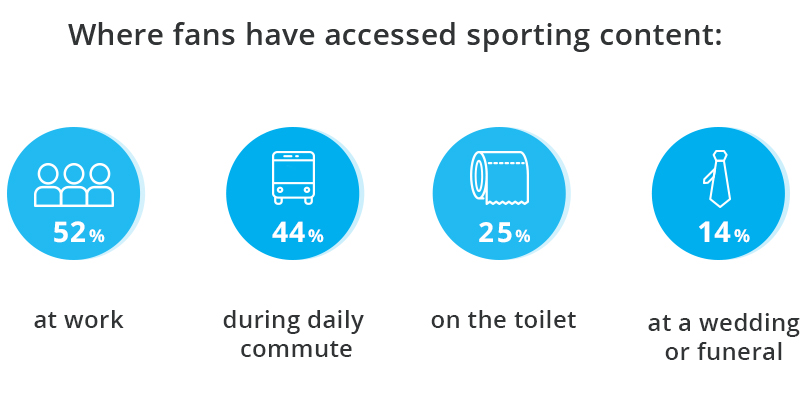
If you want to learn more about video’s impact on sports bodies and federations, explore our blog and case studies section, or simply contact us to discuss how you could benefit from utilizing our Tellyo platform.
Most of the videos mentioned in this article have been made using Tellyo Pro – our cloud-based platform for frequent and regular live content production. It enables you to ingest video streams and broadcast these to social channels and RTMP destinations, while also clipping live content into videos to post on social media.
If you’re looking to clip videos for social media, there are some new Tellyo automation features to consider, especially if you’re using Opta event metadata:
- Smart Clips, which automates video clip creation from live sports content.
- Auto Clip-to-Post that lets you fully-automate clip creation through to social messaging and social posting, all in one go.
Both are giving more power to editors in their mission to deliver quality sports content to audiences quickly and efficiently.
Leverage your sports organisation to the next level with live video content
The rise of the online sports fan, social as the new channel of broadcast, digital democratising sports viewership – these are all things having a major impact on the sports industry.
Yet, at times, it might appear that only the major sports industry players are reaping the benefits of these seismic shifts towards digital channels. But, hang on…. smaller organisations can grow rapidly too and are often the ones carving the way and their own niches as they go. This is all thanks to new, mostly internet-based technology – such as cloud-based live stream production, and social video editing and distribution platforms – which are reducing the gap between the biggest clubs or federations and smaller organisations.
At the heart is the not-so-secret-anymore weapon – live video content.
Why live video content?
Put simply, consumption of video content is constantly growing, and rapidly so amongst sport fans.
For younger generations, digitally served video content plays an even bigger role than TV played for their parents. Generations of ‘cord-cutters’ are not so interested in having a traditional TV set with a cable subscription. The evidence points to how they prefer to spend time watching subscription based (or free) online OTTs. Millennials and Generation Z folks have moved their parents’ affection for TV, to the web.
However, the choice between either a traditional TV or an online service is not only a matter of age of viewers: [2]
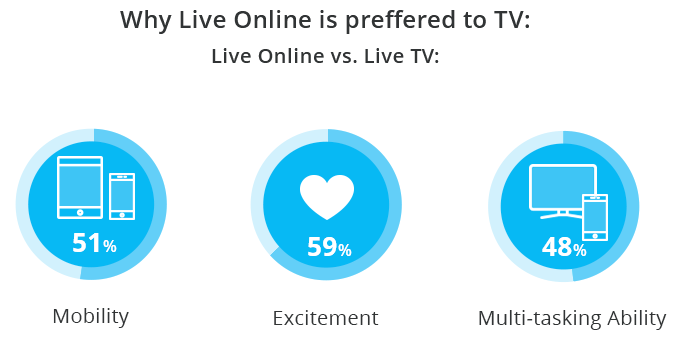
Online viewers also consider online video to be more exciting, as well being mobility-friendly and a better choice when it comes to multitasking as you watch. Sounds about right!
But if you work in traditional TV, don’t worry, it isn’t going to simply disappear. While it has some very big competition in the form of web OTTs, it’s still king of the hill and will remain in this position for some time yet.
Sharing is caring
When live video and sports combined, what we’re all seeing now is sports brands becoming content companies.[4] But what do I mean by this? Different kinds of sport bodies – clubs, federations, leagues etc – are producing tons of content and sharing this with fans.
The biggest players, like Spanish or English football leagues, might well be selling broadcasting rights to the top TV stations and TV producers. But in order to keep their fans motivated and committed, they also create and share a lot of other stuff that’s not usually televised via traditional TV. See the Tellyo blog on the best examples of such content: Ideas for online video content when you can’t show games.
For example:
- Press conferences
- Injury updates
- Other teams’ matches
- Stadium tours
- Pre-season games etc.
Elsewhere, the Union of European Football Associations (UEFA) is planning to open their own OTT platform with live video content to complement paid TV. While UEFA is certainly a big fish, they do have lots of events that are not as popular as say the Champions League, such as games featuring women teams, pre-season preparations and matches, injury reports, and interviews with players.[5]
There’s a lot of content that is absolutely worthy of spreading beyond UEFA itself. That’s why the organisation’s latest idea is to make more content eligible to be streamed or recorded as a video. And there’s no better way to promote sports events than video:

This situation can be a huge opportunity for many smaller organisation or lesser known parts of sports institutions. What’s more important – they don’t need huge facilities and resources be able to achieve great marketing, PR and sales results with sport video content. How come?
You own content… Make use of it!
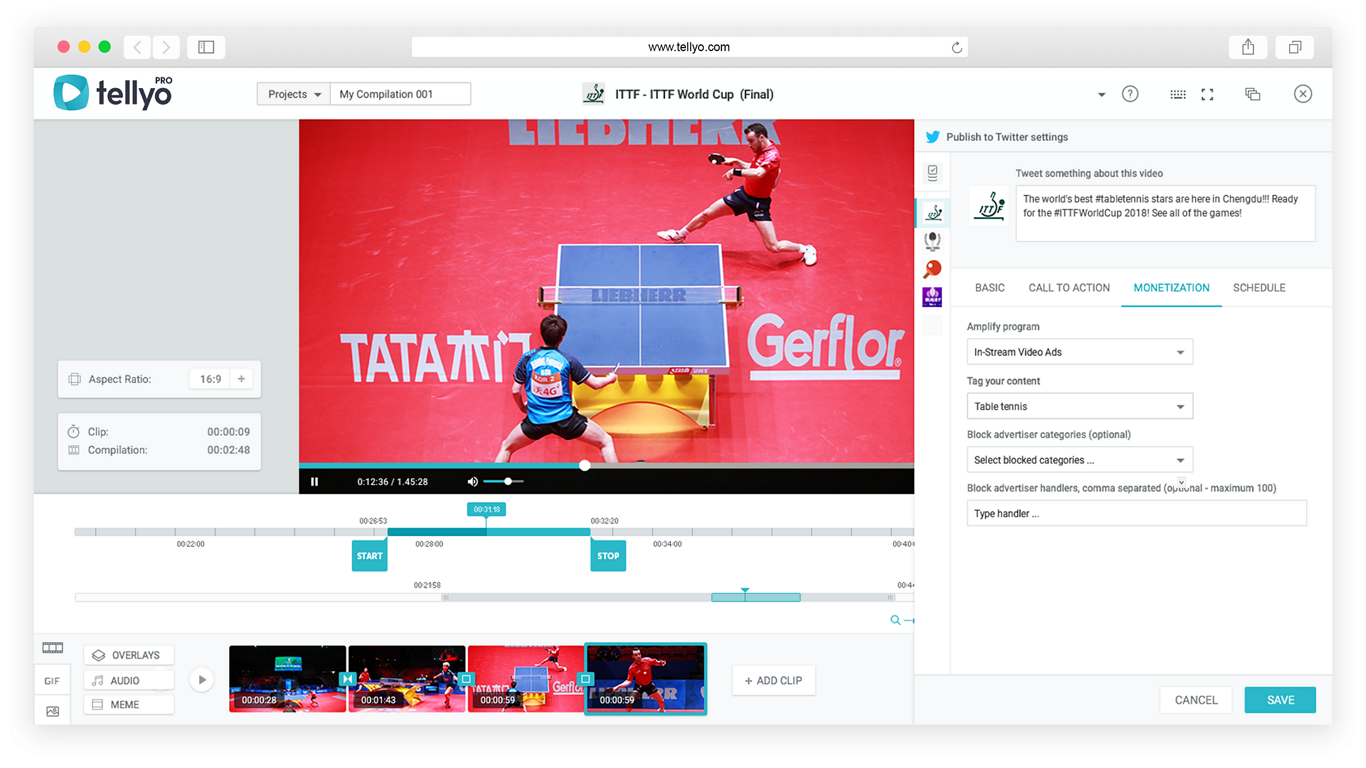
Technology makes it all possible. Recording videos and streaming broadcasts to social media, on a professional level, is very obtainable to all. You don’t need a production control room with multiple screens, tons of electronic devices, or a team of engineers. That’s NASA you’re thinking of! Instead, you need video recording device (camera, iPhone, drone), a decent internet connection and laptop to run video production software. Software like Tellyo Pro, for example:
Our Tellyo Pro is a professional cloud-based platform for frequent and regular live content production. It allows you to ingest video streams to Tellyo and broadcast these to RTMP and social channels, while also clipping live content into videos to post on social media.
Stream Studio is our cloud video production suite that enables you to create dynamic live streams for social channels, with extras like graphical and video overlays and sound mixing.
If you’re using Opta Sports event metadata for example, you can now also automate video clip creation in Tellyo Pro with Smart Clips, giving more power to your editors to quickly create video compilations. Our Auto Clip-to-Post feature means you can also fully-automate clip creation through to social messaging and social posting, all in one go.
For more detailed and data-driven stories, check out our case studies section.
To grow or not to grow?
The facts speak for themselves: live video content can be a leverage to promote your organisation, league, club or sport in general. Video content production is no longer exclusively reserved for the TV and sports giants. As long as you own it or have the rights to it, you can use your events as great video content. You will gain new audiences and please your existing fans, so let your sports video content be your ace!
If you would like a demo of any Tellyo solutions mentioned above, please don’t hesitate to contact us – we’re more than happy to help!
ITTF – from strength to strength with online video strategy
The International Table Tennis Federation (ITTF) is the governing body for 226 worldwide associations and oversees more than 120 international events. It is one of the largest sports federations in the world and has a proud history, having organised the World Table Tennis Championships since 1926.
Our partnership with the ITTF started back in 2017 and has since gone from strength to strength. Today, Tellyo is integral to the ITTF’s direct-to-fan video strategy, enabling the federation to stream matches and share clips
from tournaments previously difficult to access for fans across the globe.
Increased global streaming collaborations
Starting with one trial tournament in 2017, Tellyo now supports all of the ITTF’s major tours and championships. More recently, our platform has been used during regional events in remote locations within Fiji, Nigeria and India.
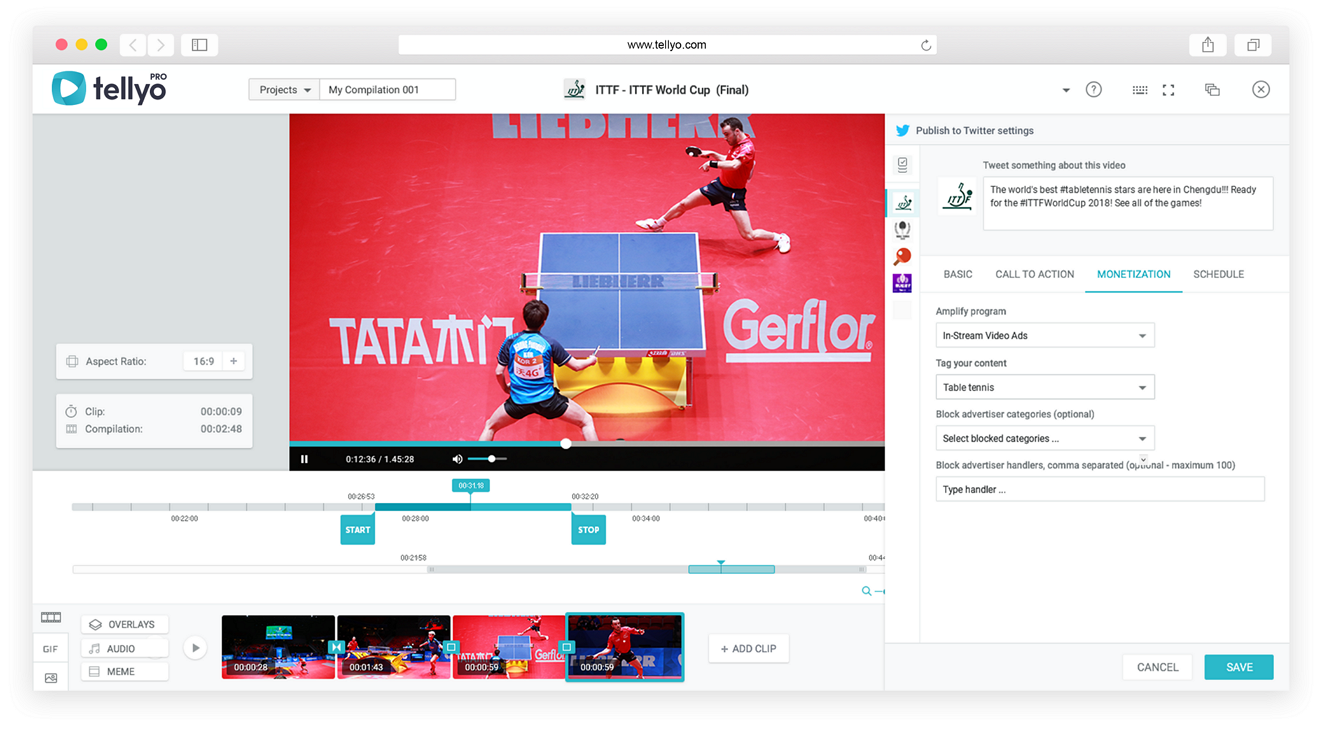
When working in remote locations, the ITTF rely on us to seamlessly deliver streamed content to global fans online. The key to our success is two-fold. Firstly, our platform’s infrastructure is capable of receiving signals from anywhere in the world, however remote, thanks to the network of servers we use. Secondly, we provide an extensive set of advanced tools to ITTF production teams, expertly meeting their various technical requirements.

Video clips further boosting engagement with the ITTF
With a greater number of tournaments being covered, the ITTF is seizing these opportunities to create more video clips for its social media channels. In turn, these clips help to drive viewers to its live stream and are having a hugely positive impact on overall engagement with the federation and table tennis online.
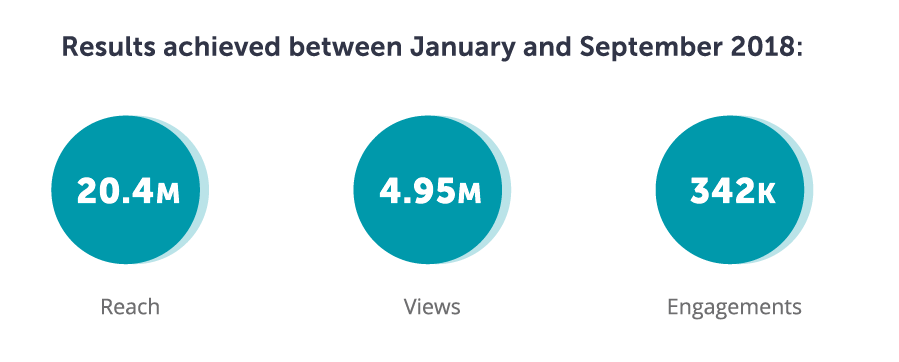
“I cannot imagine life without Tellyo. The platform is at the core of our social video strategy, helping us to showcase dynamic sports content from multiple ITTF tournaments online. All-in-all, thanks to Tellyo, we’re better able to entertain and excite our fans, dramatically improving our digital reach, video views and fan engagement levels across social media.”

Visit our stand at Sportel and try our new solutions
One of the most prestigious events in the sports marketing and media industry, Sportel is the place to meet influential leaders and see cutting-edge technology in action.
At Sportel Monaco we invite you to come by our stand and chat with us about the benefits of using Tellyo in your organisation. We can also show you how our exciting new solutions work.
Visit us at Sportel Monaco on stand A40/A41 between 22 and 24 October. Either send us en email on meet@tellyo.com, arrange a meeting beforehand or simply drop by our stand to say hi!
The new solutions you’ll get to meet
Stream Studio is advanced live production tool that enables your digital and social teams to create dynamic live streams for social channels, providing an immersive experience for fans. Request a demo>
Smart Clips equips your teams with an intelligent tool for creating short videos quickly and easily, thanks to event meta data provided by Opta Sports or Genius Sports. Request a demo>
Auto Clip-to-Post fully automates clip creation, social messaging and social posting. Combined with Smart Clips, Auto Clip-to-Post multiplies the matches one editor can effectively cover. Request a demo>
For inspiration, check out this video clip compilation from Guinness PRO14 Rugby – a great example of packaging exciting moments to help shape the tournament’s narrative as the premier professional club competition in Ireland, Italy, Scotland, Wales and South Africa.
The tries just keep coming 👊
Speed, skill, and style aplenty, Round 4 of the #GUINNESSPRO14 certainly didn't disappoint 🔥
Check out the top tries of the weekend 👉 https://t.co/S87eu5A9cQ pic.twitter.com/GlkRnnAEcl
— PRO14 RUGBY (@PRO14Official) September 24, 2018
We look forward to meeting you at Sportel Monaco!
Guinness PRO14 – how video results skyrocketed for this unique and amazing tournament
The Guinness PRO14 Championship is a global rugby tournament that pits 14 teams from Europe and South Africa against each other in an exciting league format that culminates in knockout stages and a showcase final. Our Tellyo platform has enabled PRO14 to deliver a robust video content strategy that is driven by the creation and distribution of video clips to drive fans to its live streams.

Data coming from clips created and distributed via Tellyo Pro.
What’s the secret behind PRO14’s video content growth?
Maximizing new channels
With the media landscape fast-evolving, PRO14 has been quick to create video content for new social channels. As a content rights holder, its strategy is about getting videos out to PRO14 rugby fans so they’re part of action, as it happens. As one of our beta partners, the organisation is also helping us to develop and test new products and features, such as our recently launched Stream Studio, Smart Clips and Auto Clip-to-Post.
Progressively larger deployment of Tellyo
Initially used as a test during the early league stages of the 2017/2018 season, PRO14 now use Tellyo to live stream games and to clip videos specifically for social media channels. During the coming 2018/2019 season, PRO14 will also push video content from Tellyo to its new OTT subscription platform.
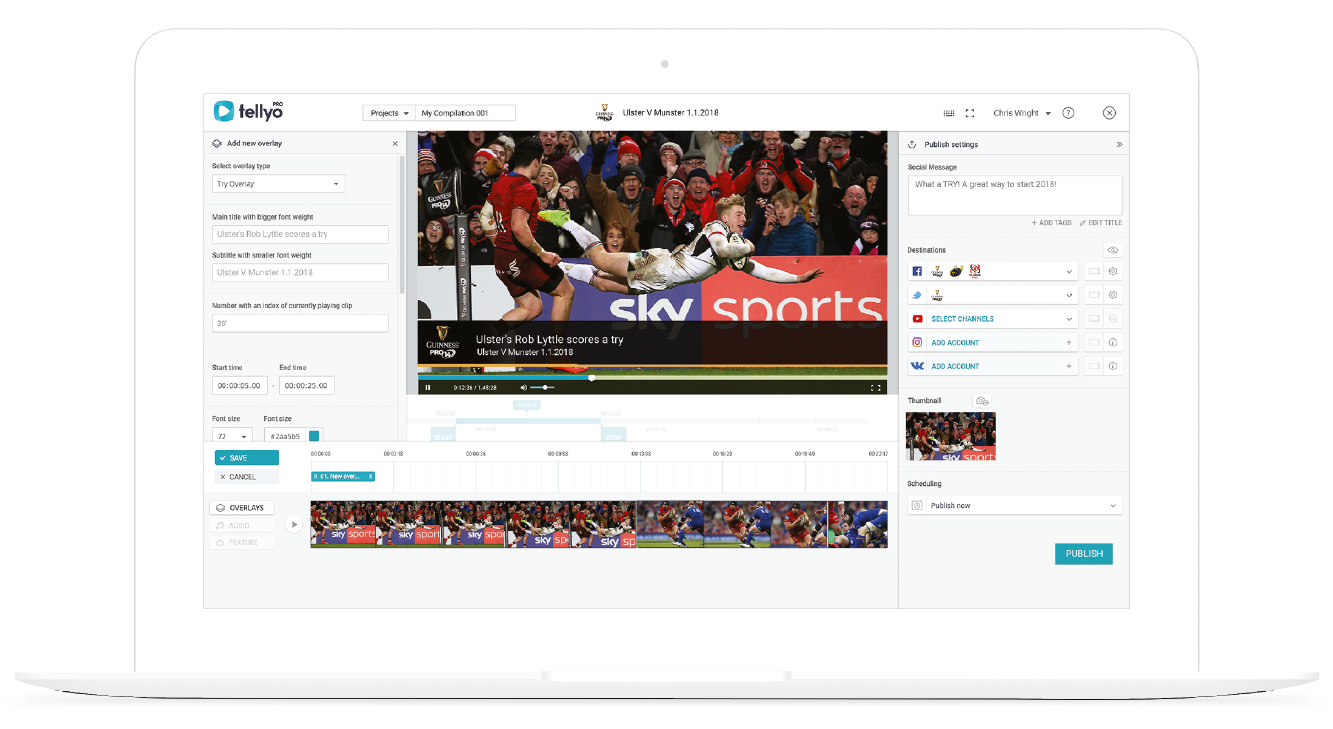
Sharing video content with PRO14 teams
With relevant permissions and access rights in place, PRO14 is able to give its teams access to Tellyo, meaning each team’s media unit can use and share PRO14 video content. This has helped to amplify tournament matches further across social media, whilst also strengthening relationships with PRO14 teams by continuously building content resources that deliver value to everyone involved.
“We’re seeing major growth in fan viewership and engagement related to the video clips we’re now able to create and share in real time. This is all down to the video strategy we have been able to enact thanks to Tellyo. It plays a significant role in our direct to consumer strategy by giving us the means to elevate the online experience to new levels through engaging and timely content.”
Peter Connolly, Digital Manager at PRO14 Rugby
Sunset+Vine – TV and digital sports producers mastering their game
Sunset+Vine is a global force in TV and digital sports production. As one of our largest and longest-lasting clients, we’re extremely proud to continually develop and evolve our partnership. We now work across Sunset+Vine’s many sports assets, while they invest time in supporting our beta and product developments, better enabling us to achieve success together.

Multi-casting Hong Kong World Sixes:
Sunset+Vine utilised Tellyo Pro as a dynamic means to deliver various live streams from last year’s Hong Kong World Sixes cricket tournament. With the support of our customisations, its team successfully and cost-effectively multi-casted simultaneous streams to platforms such as Facebook, YouTube, Akamai, Fox.com and Cricket Australia’s website, cricket.com.au.

Numbers from using Tellyo Pro at the Hong Kong World Sixes.
Creating and sharing ECB cricket clips
As the production company behind all England and Wales Cricket Board (ECB) events, Sunset+Vine were tasked with packaging engaging highlights of national team games for social media. To produce clips out of live streams and provide instant highlights to cricket fans, the ECB production team turned to Tellyo Pro.

Data coming from clips created and uploaded to Facebook via Tellyo Pro.
Live streaming and clipping Crufts:
Established in 1891, Crufts is the biggest canine event in the world with a modern audience hungry for online content. To deliver fresh content to fans, Sunset+Vine’s production team now run 12 hour+ livestreams and edit and distribute video highlights across social media channels, all via Tellyo Pro.

Data coming from broadcasts streamed to YouTube and clips created and uploaded to YouTube via Tellyo Pro.

“Tellyo gives us the speed of deployment we require, and the reliability and strength of its streams are outstanding. The team has helped us immensely by developing adaptations within their infrastructure to meet our streaming requirements for all destinations.”
Awesome viewing as Dutch cyclist Beukeboom claims 4th longest distance for UCI Hour Record
Last night, Dutch racer Dion Beukeboom attempted to break the Union Cycliste Internationale (UCI) Hour Record, gunning for Sir Bradley Wiggins’s iconic feat from three years ago.
Chasing the record at the Aguascalientes velodrome in Mexico, Beukeboom recorded 52.757 kilometres, ranking him 4th in distance covered in the illustrious event but still shy of Wiggins’s amazing mark of 54.526 kilometres which was set at London’s Olympic Velodrome in 2015.

Enabling global fans to witness this latest attempt at cycling’s most prestigious record, the UCI live streamed the event to Facebook and the UCI YouTube channel (tv.uci.ch). It also used Tellyo to create and share short clips of key moments to social media throughout Beukeboom’s attempt.

“Tellyo is delighted to have worked with the UCI on such a prestigious event. Through Tellyo, the UCI were able to capture key moments of the attempt, and create and share video edits, GIFs and still images across their social media, helping to engage their audience, share updates on progress and ultimately guide more viewers to the live stream.
“It was compelling viewing and congratulations should go to Beukeboom – it was a superb effort and truly awesome to watch.”
The most common live video streaming habits of digital audiences
It’s extremely difficult to pin down live video streaming audiences. Data will vary depending on world regions, such as a country’s internet quality, its level of technology adoption and development, and so on. However, a new report has done an incredible job of helping us to build a better understanding of digital viewers, as much as it’s possible.
The IAB (Interactive Advertising Bureau) report – Live Video Streaming: A Global Perspective – provides a great benchmark regarding trends across live video streaming. It’s a must read for anyone interested in the broadcasting industry and for people who want to stay up to date with the most recent studies. Here’s a short, but insightful summary of the survey’s results.
Check out our other stories:
- Ideas for online video content when you can’t show games
- Will the real host of the 2022 FIFA World Cup be the web?
- Still looking for a prime alternative to Snappy TV?
An overview of live video streaming consumption
The IAB report highlights that we are all surrounded by devices that enable us to watch video streams – such as PCs, laptops, smartphones, tablets and web connected TVs, all of which are some of the most common screens we use to catch the content we want to see.
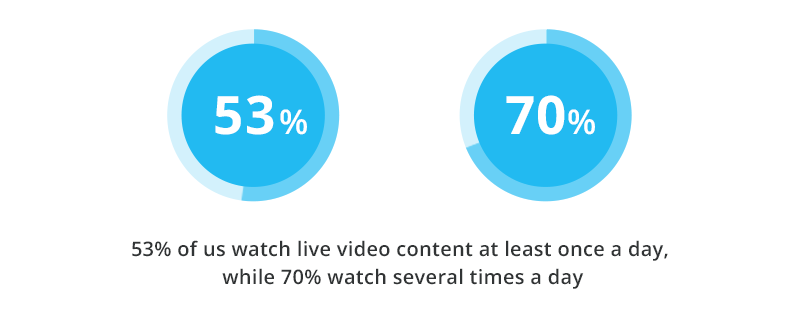
The report also makes a strong point that video streaming is still growing rapidly. Forty-seven per cent of people who took part in the IAB survey said that they stream more videos in 2018 than they did a year ago. Russians are a model example of what the report calls the ‘video thirsty user’, as 61% of Russian respondents said they watch more streams now than a year ago.
How we watch content
Out of all of our web-connected devices, smartphones are the most popular when it comes to watching video streams (for 62% of survey respondents). In second place comes the PC/laptop, while tablets come third. The reports notes that the most popular ways to watch video streams is further reflected in the devices people keep at home, as listed below.
“What device I own or have access to”:
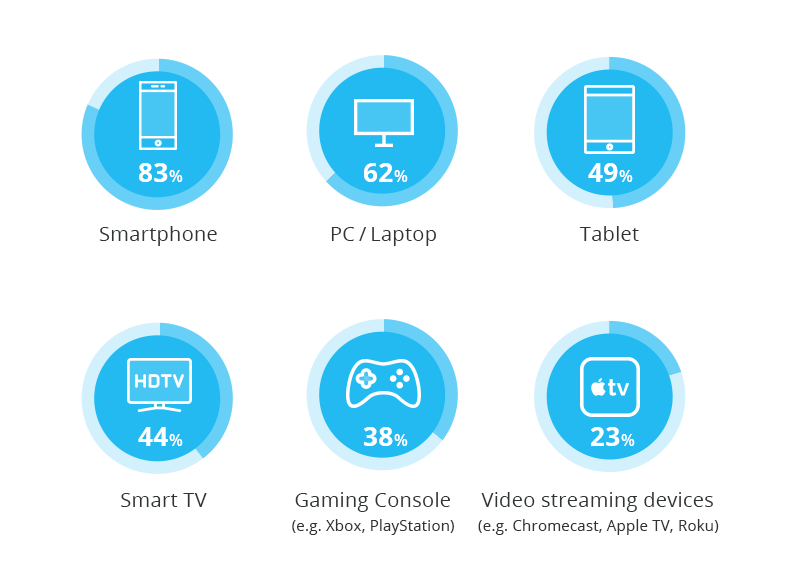
The ever-present smartphone is noted as the device on which we watch live video content most frequently – 67% of respondents use them at least once a day or several times a day. In terms of use, the second device is a Smart TV, while tablets and video streaming devices (Chromecast, Apple TV) come joint third.
However, while we might use smartphones to watch live video content most often, the report concludes that the device is not the best platform for longer formats.
It seems that audiences around the world prefer to watch long formats, or videos for longer periods of time, on bigger screens. The Smart TV comes top with 67% watching more than 30 minutes of live streams daily; while video streaming devices (that are connected to and watched through a TV) follow closely behind on 62%. Only in 47% of cases are smartphones used to watch video for 30 minutes or more.
Audiences prefer to watch longer video content on bigger screens, while smartphones are often used for short videos no longer than 10-30 minutes in length.
Where we consume content
Social media now plays a key role in many areas of life. Unsurprisingly, viewers like to watch live streams mostly on social media (52%), with dedicated, digital streaming platforms with subscriptions coming in second place (41%).
The report highlights that social platforms are a natural place for streaming and probably one of the best places for viewing:
- (Almost) everyone can access social media streams, as long as they have a web connection.
- Social media is free to use.
- Social channels are widely accessible via almost any web-enabled device you can imagine: PCs, smartphones, tablets, Smart TVs, gaming consoles etc.
- Social offers specific features that help broadcasters to promote and inform users about a stream.
- Users also benefit from specific features, such as the ability to chat during a stream.
Digital streaming subscription platforms, like Hulu Live or DirectTV Now, are dedicated to digital entertainment and offer access to multiple TV channels using a connected device. Users can watch anywhere, either live or on-demand at a more convenient time.
Other, popular sources of live video streams are:
- TV network websites or apps (like ITV Hub, All4 or other web services that provide live streams from traditional TV broadcasters) – 34%
- Gaming websites or apps – 33%
- Paid TV service provider website or app – 21%
- Other sources – 9%
Content we like to consume
The most popular type of content that is streamed by digital viewers around the world is the TV series (for 45% of users).
Thirty-one per cent watch live sports, with 30% tuning into how-to tutorials. Gaming fans represent 29% of live video content consumers. What’s interesting is that live videos made by friends or family members are appealing to 28%; while news is interesting for 27%, videos made by an online celebrity or influencer for 24%, live concerts for 23% and talk shows for 22%.

There isn’t anything too surprising about the above types of content we like to consume. For most people, a box-set TV serial is the go-to content across the web in general, including video on-demand (VOD) and live streaming services. Live sports events are then an obvious second, as sport is all about being ‘in the moment’.
Where we consume
Gone are the days of a TV set in every room, probably forever. Live content is now everywhere, across laptops, smartphones and tablets to name just a few. These new screens are often the first thing we look at in the morning and, quite probably, the last thing we look at before going to sleep.
According to the IAB report, 73% of live video content is consumed at home. Outdoor consumption appears to be alongside journeys and social events, like going to a restaurant, bar or the park, or on the way to work and while shopping.

Thirty-seven per cent of viewers spend 81% or more of their time live streaming in the company of others, which increases to 56% of viewers when using a smartphone. This is worth remembering, as it means that up to just over half of your streaming audience will be more than one person, depending on the device being used.
How we multi-task while watching live streams
While watching live streams an audience’s attention is highly distracted. But this doesn’t mean that they don’t pay attention to what they see on the screen. In fact, while they will do other things, these are more often related to what is being watched.
Things (related to what is being watched) that viewers do while watching live content:
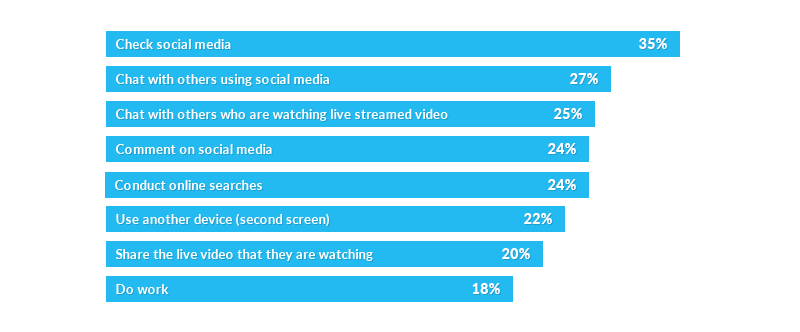
Why we watch live streams
So, what exactly does an audience look for in a live stream? The IAB report asked respondents – What are the main reasons for you to watch live video streaming content? – and the responses shed light on why we watch:
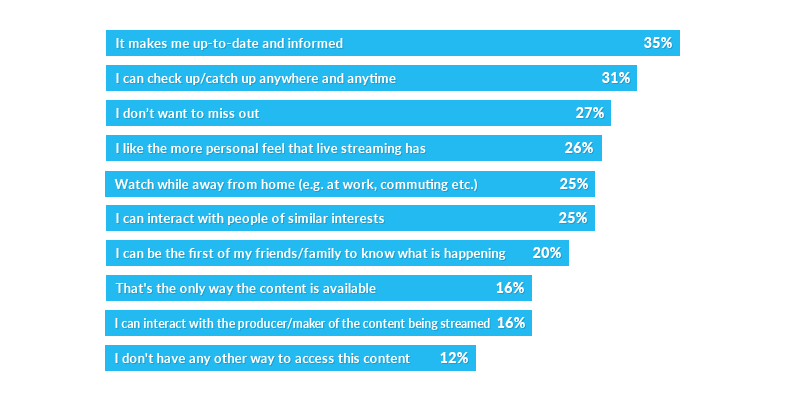
Something that should be of valuable insight to many live content industry professionals, the report also asked: Which of the following factors influence your choice of live video streaming sources?
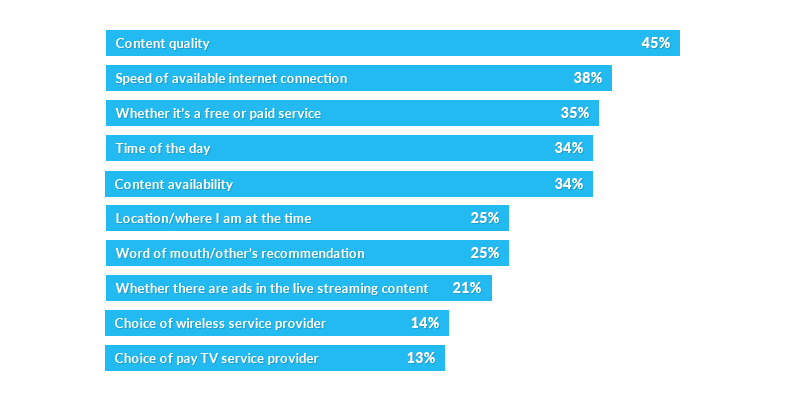
It seems that technical aspects, such as content quality and the speed of connection, are crucial here, while ads (or the absence of ads) in a live stream are not so important after all.
Key takeaways about the live video consumer
Based on the IAB report’s survey results, if we were to create a persona for the ‘live video content consumer’, the following would form their habits and thoughts. They would:
- Watch live video content a couple of times a day
- Own a smartphone and use it to stream live video content
- View streams via social media channels
- Favour TV serials and sports
- Enjoy watching live streams in the late evening – from 8pm to 11pm
- Check social media and look for related online content while watching a stream
- Appreciate content quality and connection speed
- Like how live content makes them feel up to date and well informed
Although the above makes some pretty big generalisations, once you start to glean new insights from reports such as the IAB’s, then you can build a better picture of the live video content consumer. Worth remembering!
Reaching the live video streaming consumer
When it comes to execution of your live video strategy and getting the tools to reach the live video consumer described above, simply try one of our Tellyo solutions. Tellyo Pro is for regular, extensive broadcasts; while Tellyo On Demand is designed for more occasional use. If you’re not sure which solution would suit you, please get in contact and the team here will be more than happy to help.
Will the real host of the 2022 FIFA World Cup be the web?
With massive stadiums, world-wide federations and leagues, and global superstars, Football is undoubtedly the most important sport in the world. Its popularity spans the globe, while the quadrennial FIFA World Cup is always a huge spectacle that goes beyond sport. It’s a game of fame, money and status, and a coming together of different cultures and styles.
The world’s eyes are all on the tournament in Russia right now. The event is being beamed and streamed to every corner of the globe. And thanks to TV infrastructure and extensive internet access, fans can watch games in all sorts of places – from pubs and fan zones to Mongolian yurts and even small, remote islands on the Pacific.
Check out our other stories:
- Ideas for online video content when you can’t show games
- The most common live video streaming habits of digital audiences
- Still looking for a prime alternative to Snappy TV?
But how is our viewing changing and what will this look like for the next World Cup in Qatar 2022?
How we watched the 2014 World Cup
During the 2014 World Cup held in Brazil, an estimated 280 million people watched matches online or on a mobile device, according to official FIFA data[1].
As the rights owner, FIFA reached 207 territories with its content (the definition of ‘territory’ being a bit wider than a “country”). The final was watched by approximately 695 million viewers at home (calculated as people who watched at least 20 consecutive minutes in their own home). However, the final figure was surely higher, as many viewers will have watched in their favourite bar or in specially prepared fan zones. Yet it was still a 12% growth when compared to the 2010 World Cup in South Africa.
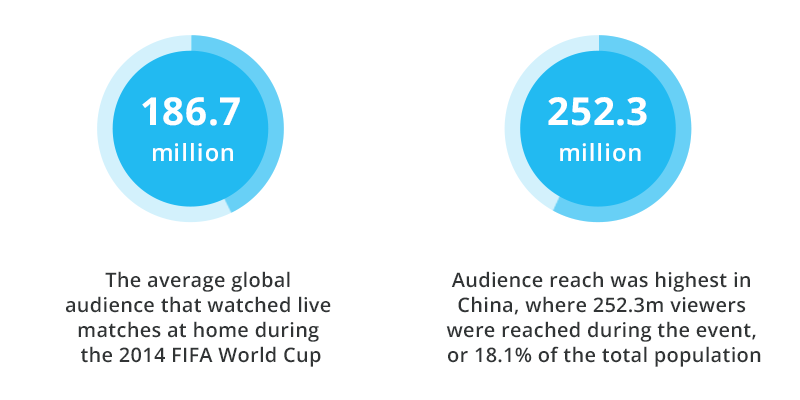
According to FIFA, there was more online coverage in 2014 than any previous World Cup tournament, with 188 licensees offering coverage via websites, media players and apps.
What’s more, since 2014 consumer surveys suggest that online TV viewing is up by 36%, while mobile TV viewing has increased by 248%. Obviously these viewing figures have been boosted by technological developments, increased broadband penetration, better devices, and faster internet speeds in all regions.
It seems that the better the infrastructure, the better the online video reach. But credit also has to go to the progressive strategies of many TV stations. With the World Cup proving so popular, national broadcasters continue to show it for free, with no extra charges. Many are committed to making content easily accessible and widely distributed by catering to all viewing habits – from traditional TV to online and mobile.
If not for free, many countries also offer lots of options to pay for access to content beyond a national TV station.
How will people watch the 2018 World Cup?
To see the detailed results of World Cup viewership we will have to wait until the end of the tournament. But with a huge dose of certainty – and some early indicators so far – we can predict that results are going to show a record high when it comes to online video content.
While TV is still the king of sports broadcasts, online live streams are fast gaining traction.

Released just before the 2018 World Cup got underway, a recent IAB report – Live Video Streaming: A Global Perspective – provides us with a better picture.
What’s really interesting is the number of different media platforms that will be used during the 2018 World Cup.
The IAB report asked:
Which, if any, of the following media channels and devices do you plan to use to watch/follow the 2018 FIFA World Cup?
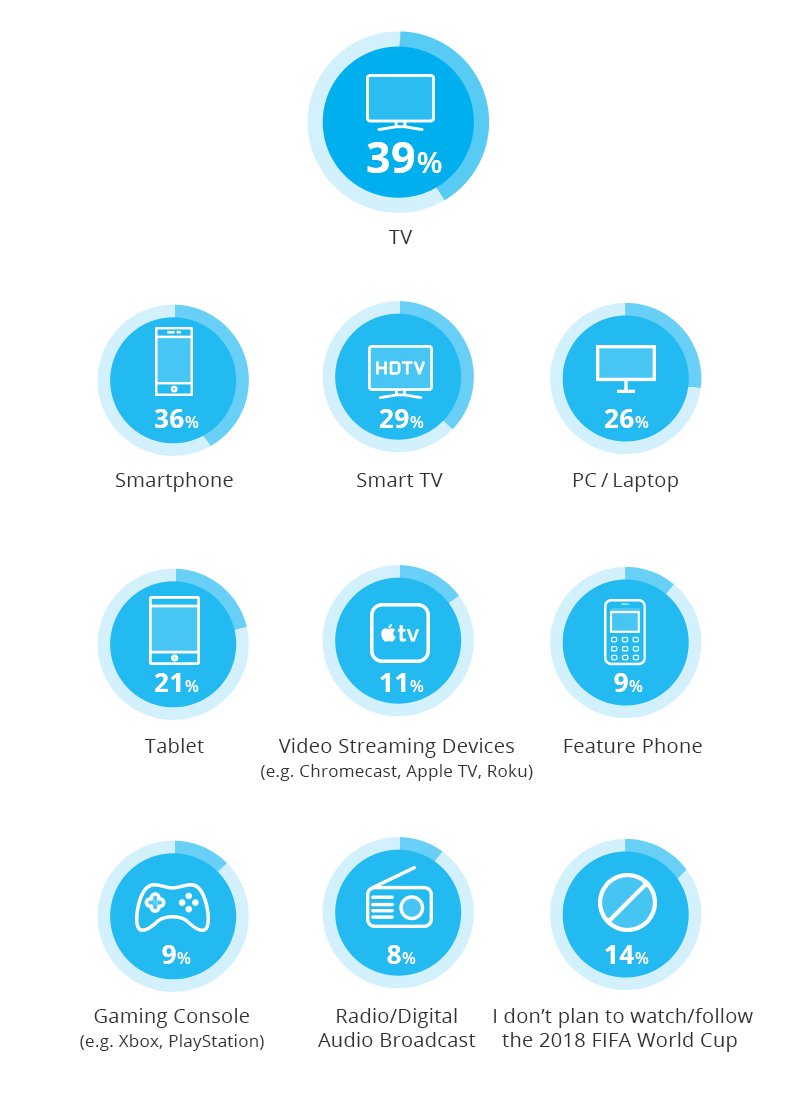
When taking a closer look at the above list, what’s noticeable is that most of the devices will need an internet connection to access World Cup video content such as games.
It gets even more interesting if we go further and look at those answers from geographical regions. According to the report, smartphones are the most popular option (45%) for watching World Cup games in the APAC region (Australia and China), while South Americans prefer TV (49%).
Looking ahead to 2022
It’s a bit too early to write any final conclusions about how we watched this year’s World Cup. But looking at data from 2014 and the available audience insights prior to the tournament in Russia, it looks like online access will be at a record high regardless of the device or platform being used to watch content. Perhaps the 2018 FIFA World Cup will prove a breakthrough for online broadcasters. If so, surely the 2022 tournament will be even more wireless and web focused. It’s time to go online!
[2] Live Video Streaming – A Global Perspective – IAB Report, June 2018
How to reach Russian sports fans during the FIFA World Cup 2018?
When it comes to the web, Russia is a well-connected super power. It boasts the biggest internet nation in the whole of Europe – a whopping 76% of its citizens are online, which equates to nearly 110 million users. Most of them are using Vkontakte social media platform.
Russia is a market probably unlike anything you know – where Facebook and Google are not the first choice for users; where audiences still love western brands and have a huge appetite for great video content.
With the FIFA World Cup just weeks away, the key to success is VKontakte (VK) – Russia’s answer to Facebook. But what exactly is VK and why do Russians prefer it over other social channels? How can you create a presence on VKontakte (VK) and get more followers for your brand?
Download our e-book to learn for yourself. It’s your essential guide to reaching Russian sports fans during the FIFA World Cup 2018.









